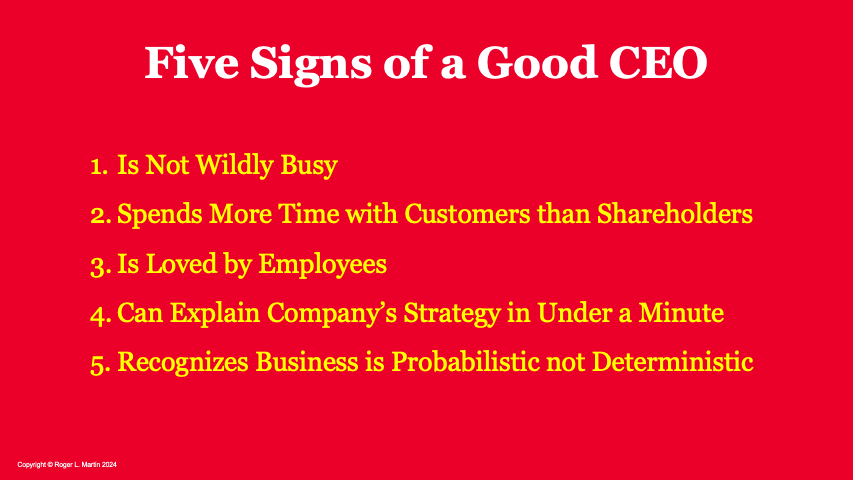Five Essential Features
A reader (Zach) asked seemingly simple question: What are the signs that a CEO is a good one? It struck me as a both sneakily good and interesting question. Are there simple and reasonably readily observable features of a good CEO that employees, customers, and investors could scutinize to predict success or lack thereof? I think there are, and I give my point of view in this Playing to Win/Practitioner Insights piece: The Signs of a Good CEO: Five Essential Features. All previous PTW/PI can be found here.
These are in no particular order of importance. I have written them in the order that they occurred to me when I put my mind to Zach’s question.
Is Not Wildly Busy
Maybe because AG Lafley and I are writing something on CEO time allocation (out in the spring), this feature occurred to me first. The antithesis of this feature was embodied by one of the worst in my 43 years of working with CEOs. I admit to being spoiled. I get to work with a lot of terrific CEOs, so the really bad ones stick out more prominently. I often work with the latter at the behest of the board/chair — which was the case here. He wouldn’t have hired me in a million years.
He was almost unbelievably busy. His calendar featured meetings from sunup to sundown — every day. I have seen many busy CEOs, but this set a new standard. I observed little ability to discern between important activities and trivial ones. Because he felt he needed to schedule so many meetings, they were all short. So, whenever there was anything truly important to discuss, there wasn’t enough time. It required the scheduling of another far-too-short meeting, and maybe another and another.
When he was fired by the board, I assume he thought it was despite how hard he worked. My view was that he was fired because of how hard he worked — not directly of course, but because of the consequences of someone who can’t figure out what is important and what is not.
When a CEO is wildly busy, it is evidence of the inability to figure out what is important and what is not. And that is deadly. No magnitude of work can overcome this problem.
What you should want is a CEO who is nicely busy — not wildly busy, just busy. For sure you don’t want one who is lazy. There are some who are, but not that many of them in my experience. Laziness is not a big problem in assessing CEOs. You should want one that is hard working but not going back and forth between one thing and another in a wild frenzy.
Spends More Time with Customers than Shareholders
Any CEO who spends more time with shareholders than customers simply doesn’t understand cause and effect — and that is a really bad sign. The core job of a CEO is to make sure that the company makes an integrated set of choices that compels desired customer action. That means developing an understanding of customers that is thorough and deep enough to make a set of choices that compels them.
Paradoxically, spending time with shareholders doesn’t result in good things for shareholders. That is despite the belief in the gatekeepers for the true shareholders — the money managers, pension funds, and equity analysts — that it is tremendously important for CEOs to spend time sucking up to them. Of course, that is unsurprising because gatekeepers always want to be respected/feared for guarding their gates.
But spending time with them does nothing for making an integrated set of choices that compels desired customer action. And without such desired customer action, shareholders won’t get positive results.
If a CEO focuses on figuring out and delivering on what might compel desired customer action, good things will happen for the shareholders. That is the direction cause and effect flows — not from shareholders to customers but from customers to shareholders.
Thus, if you observe a CEO spending more time to talking to shareholders (well, in fact, their gatekeepers) than to customers, the CEO is very unlikely to be a good one.
Is Loved by Employees
Employees need to feel that they are led by a benevolent soul. I understand that this goes against the famous (maybe more accurately, notorious) admonition for leaders from Niccolò Machiavelli in The Prince: “It is better to be feared than to be loved, if one cannot be both.” I respect Machiavelli and think there are valuable insights in The Prince. But that was a far different and more brutal context, of warring principalities and kingdoms, than modern day business.
Modern workers need to believe in the cause of their company. As Peter Drucker observed in Management Challenges for the 21st Century, the modern knowledge worker has more in common with a volunteer of a charitable organization than a classical hourly or salaried worker. He argued that modern business leaders need to “accept the fact that we have to treat almost anybody as a volunteer.”
For workers to truly believe in the cause of their company, they need to feel a genuine warmth toward their leader. I don’t think it is exaggerating to characterize the emotion as love. For that to happen, CEOs must be willing to work on shortening the distance between themselves and their workers. On this front, I think my friend Tom Peters was prescient in featuring ‘management by walking around,’ in In Search of Excellence two decades before Drucker’s ‘volunteer’ characterization above.
A prerequisite for loving their CEO is for employees to be at least reasonably proximate to that CEO. Of course, in the modern giant company, a CEO can’t meet all employees. But the goal should be as few degrees of separation as practically feasible. If you are a full-time employee who has five years (give or take) of tenure, you should at worst know a fellow employee who has met your CEO — i.e., two degrees of separation. If it is three or more degrees for longer than five years, the employee won’t feel warmth toward the CEO and certainly won’t feel like a valued volunteer for a cause. At 25 years, it should be one degree — and if your organization is so big that you view this as impossible, then don’t worry about it — you will be smaller pretty soon.
To do this, a CEO must genuinely like the people in the organization. You can’t fake it. Employees know. Anyone who walked a Costco with former CEO Jim Sinegal knows this. He loved his colleagues — every single one of them — and they loved him back.
Can Explain Company’s Strategy in Under a Minute
A key positive sign is that the CEO can explain the company’s strategy in less than a minute — the moral equivalent of an elevator pitch. It is a good sign because a strategy that can be stated so simply and clearly by the CEO will enable and empower employees throughout the company to make decisions that are consistent with the strategy.
If the CEO can explain the company’s strategy in less than a minute, then probably everyone down to the front-line can do so too. I will always remember a billionaire founder of a mutual fund company who, whenever I visited his organization, would take pride in asking any random employee we encountered to tell me the company’s strategy, and then pointing out to me how all the answers were identical — and he was clearly loved by his employees.
If the CEO can’t, the company probably doesn’t have a strategy that will underpin success. Part of the reason is that it won’t be sufficiently clear to guide employee actions. As I always say, without a clear strategy, you can’t tell in advance what is a good, bad, or indifferent decision. That is why simplicity and clarity of strategy is such an important sign of a good CEO.
Recognizes Business is Probabilistic not Deterministic
A good CEO recognizes the stochastic nature of business — and life in general, for that matter. Little in business life has a probability of 100% — or 0%. Despite that, many CEOs view business as inherently deterministic — “we did x, so it is legitimate for us to expect an outcome of exactly y.” That is how they see things like plans, budgets, and decisions of subordinates — “our plan said that if we spend x dollars on this initiative, it will generate y incremental dollars of profits.” If it doesn’t produce exactly y dollars, somebody is at fault for the ‘mistake.’
Because employees generally understand that life is probabilistic, if the CEO insists on acting deterministically, employees will put huge buffers into all their activities. For example, they will set any plan to produce an outcome at the extreme low of the probabilistic range. The CEO will wonder why the company has become so conservatively bureaucratic — and never figure out it that the root cause is the CEOs own deterministic mindset.
Instead, a sign of a good CEO is a probabilistic mindset — which is a mindset consistent with the way the world actually works. A good CEO implicitly or explicitly embraces statistical process control (SPC), which holds that all systems produce outcomes that embody variance. Thus, you should determine the natural variance of the system in question — the control limits — and as long as an outcome is within the control limits, it is a good outcome. Even if the outcome is negative but within the control limit, it is a mistake to start tweaking the system because the outcome is within the expected variation.
A CEO with this kind of probabilistic mindset will have an organization that can operate in synch with how the world works instead of conforming itself to an unreal deterministic conception.
Practitioner Insights
Of course, most readers aren’t CEOs because only an infinitesimal percentage of businesspeople are CEOs. But everyone should aspire personally to be more like a good CEO. Plus, if you are considering investing your time and/or your cash behind a CEO, I recommend you evaluate the CEO against these five easily observable characteristics — and invest, or not, accordingly.
If you are wildly busy, you lack discernment and you need to start working on improving it. If you are good, you will always be busy because your hours will always be in high demand and it is imperative to have a strategy for determining what is truly important and necessary for you to do, and what isn’t. (I have written about the personal dimension of this earlier in the series.)
If you are spending more time with shareholders than customers, you don’t understand the fundamental direction of cause and effect. Time spent with shareholders is more likely to result in the perceived need to spend still more time with shareholders than it is to result in happier shareholders. So, reverse your priorities to follow the true direction of cause and effect.
If you aren’t loved by your employees, think about changing your priorities and your mindset. If they don’t like you, they are going to stop volunteering their lives to you — regardless of what you pay them. Without employees who can help bring your strategy to life, your strategy isn’t worth the paper it is printed on.
If you can’t explain your strategy in less than a minute, you have two choices. Either figure out how to do so or recognize that your strategy is too vague and amorphous to ever be explained in a minute — and thus confusing not clarifying to customers, employees, and funders.
If you think the business world is deterministic, wake up. It isn’t. It is probabilistic. Figure out how to manage in a probabilistic context, or your employees will treat you as an oblivious leader who they wish they could swap out.
Whether you are a CEO or aspire to be one someday, if you are not exhibiting these five observable characteristics of a good CEO, I recommend you start upping your game.


